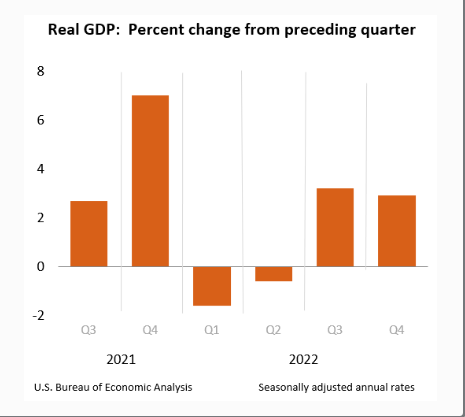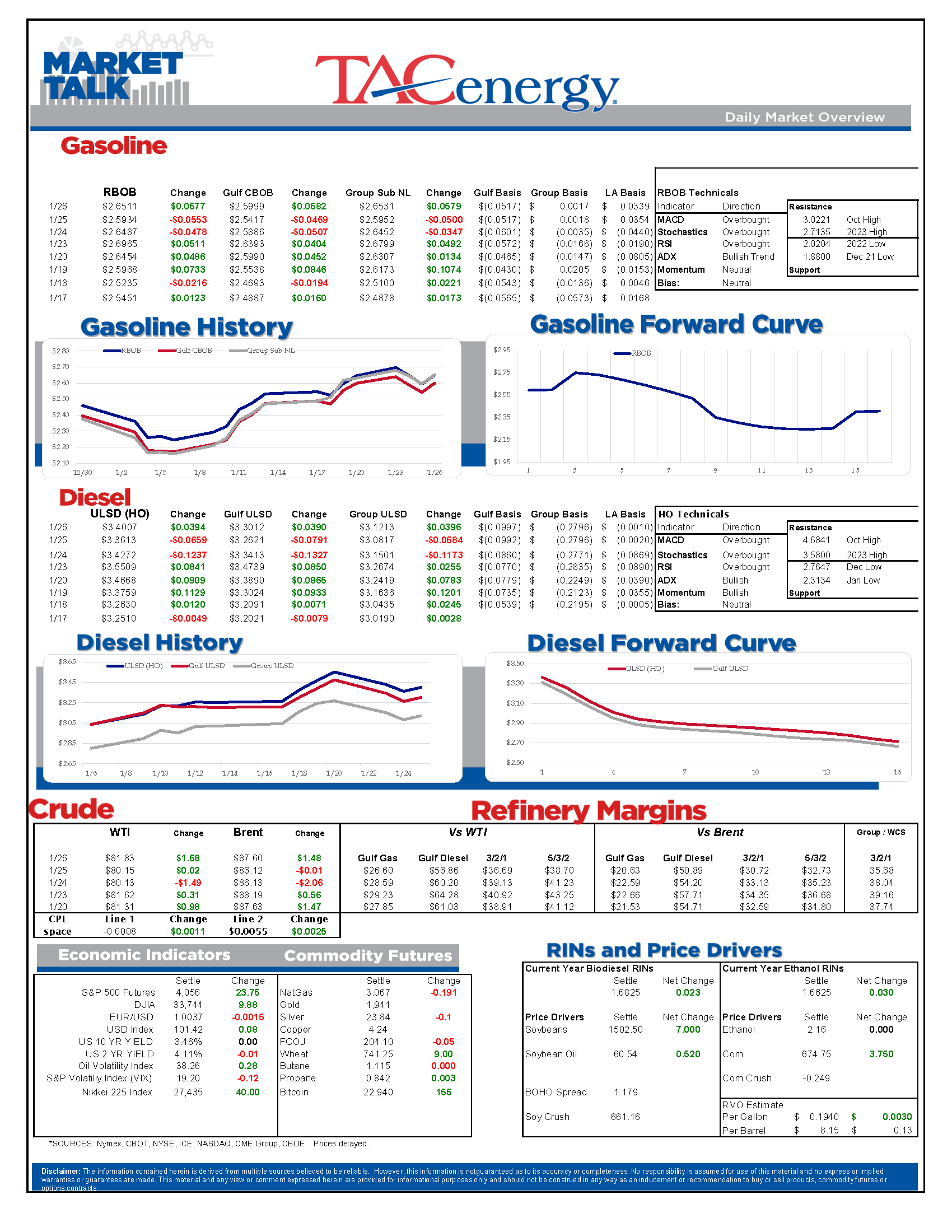Refined Products Bounce Keeping Prices Well Above Their 6-Week-Old Trend Lines

Refined products are bouncing back this morning after 2 days of selling as a bit of economic optimism appears to be creeping back into the market. The bounce keeps prices well above their 6-week-old trend lines and keeps the bulls in position to push prices substantially higher in the coming weeks and makes the past two days of selling look like nothing more than profit taking to cure an overbought market.
Stocks and energy prices reacted positively to the 4th quarter US GDP estimates this morning that showed the economy continued to expand, albeit at a slower pace than in Q3, and that the consumer continues to be resilient with purchases and savings despite so much consternation about a looming recession. International travel was noted as a highlight in this report, and could be a major theme this year as China has reopened its doors while many other countries get closer to business as usual and release the pent up demand of 3 years of COVID travel restrictions.
Despite surging exports, light imports, and no more SPR releases, crude oil inventories continue to build in the US as refinery runs continue to be far below planned levels. The recovery from the Christmas blizzard and a handful of other events in the past few weeks continues, but we’re still seeing utilization that’s several percentage points below where it would be otherwise. These lower run rates on top of already low inventory levels would be much more painful if demand wasn’t still very sluggish, and adding another anecdote for the half that think the US economy is already in a recession.
Then again, it’s also January which is typically the worst demand month of the year, and we’re in the midst of a parade of winter storms sweeping the entire country and keeping many vehicles off the road, so if we do see a normal demand rebound heading into the spring months, supply may get very tight again in short order.
Valero reported another banner quarter in Q4 this morning, and ended the year with net income of $11.8 billion, compared to $1.3 billion in 2021. The company’s refineries operated at 97% during the quarter, which was the highest since 2018 as they, along with all the others that were able, maximized output to try and help alleviate chronic inventory shortages and take advantage of the record margins those shortages bring. The report also noted that the expansion of their newest Diamond Green renewable diesel facility was completed during the quarter, and the coker project at the Port Arthur refinery which will expand capacity is due to be completed in Q2.
Total reported Wednesday that its refinery outside Houston was knocked offline during Tuesday’s severe weather event. The report suggests the plants boilers were restarted early Wednesday morning, suggesting that the facility avoided any major damage. That facility is just a couple of miles from the Deer Park refinery that was also knocked offline during the storm and restarted a few hours later. Those are the only two facilities reporting so far, while several others in the region have said their operations remain stable, so it seems we’ve avoided a major disruption from that system.
News & Views
View All
The Recovery Rally In Energy Markets Continues For A 3rd Day
The recovery rally in energy markets continues for a 3rd day with refined product futures both up more than a dime off of the multi-month lows we saw Wednesday morning. The DJIA broke 40,000 for the first time ever Thursday, and while it pulled back yesterday, US equity futures are suggesting the market will open north of that mark this morning, adding to the sends of optimism in the market.
Despite the bounce in the back half of the week, the weekly charts for both RBOB and ULSD are still painting a bearish outlook with a lower high and lower low set this week unless the early rally this morning can pick up steam in the afternoon. It does seem like the cycle of liquidation from hedge funds has ended however, so it would appear to be less likely that we’ll see another test of technical support near term after this bounce.
Ukraine hit another Russian refinery with a drone strike overnight, sparking a fire at Rosneft’s 240mb/day Tuapse facility on the black sea. That plant was one of the first to be struck by Ukrainian drones back in January and had just completed repairs from that strike in April. The attack was just one part of the largest drone attack to date on Russian energy infrastructure overnight, with more than 100 drones targeting power plants, fuel terminals and two different ports on the Black Sea. I guess that means Ukraine continues to politely ignore the White House request to stop blowing up energy infrastructure in Russia.
Elsewhere in the world where lots of things are being blown up: Several reports of a drone attack in Israel’s largest refining complex (just under 200kbd) made the rounds Thursday, although it remains unclear how much of that is propaganda by the attackers and if any impact was made on production.
The LA market had 2 different refinery upsets Thursday. Marathon reported an upset at the Carson section of its Los Angeles refinery in the morning (the Carson facility was combined with the Wilmington refinery in 2019 and now reports as a single unit to the state, but separately to the AQMD) and Chevron noted a “planned” flaring event Thursday afternoon. Diesel basis values in the region jumped 6 cents during the day. Chicago diesel basis also staged a recovery rally after differentials dropped past a 30 cent discount to futures earlier in the week, pushing wholesale values briefly below $2.10/gallon.
So far there haven’t been any reports of refinery disruptions from the severe weather than swept across the Houston area Thursday. Valero did report a weather-related upset at its Mckee refinery in the TX panhandle, although it appears they avoided having to take any units offline due to that event.
The Panama Canal Authority announced it was increasing its daily ship transit level to 31 from 24 as water levels in the region have recovered following more than a year of restrictions. That’s still lower than the 39 ships/day rate at the peak in 2021, but far better than the low of 18 ships per day that choked transit last year.
Click here to download a PDF of today's TACenergy Market Talk.

Energy Prices Found A Temporary Floor After Hitting New Multi-Month Lows Wednesday
Energy prices found a temporary floor after hitting new multi-month lows Wednesday morning as a rally to record highs in US equity markets and a modestly bullish DOE report both seemed to encourage buyers to step back into the ring.
RBOB and ULSD futures both bounced more than 6 cents off of their morning lows, following a CPI report that eased inflation fears and boosted hopes for the stock market’s obsession of the FED cutting interest rates. Even though the correlation between energy prices and equities and currencies has been weak lately, the spillover effect on the bidding was clear from the timing of the moves Wednesday.
The DOE’s weekly report seemed to add to the optimism seen in equity markets as healthy increases in the government’s demand estimates kept product inventories from building despite increased refinery runs.
PADD 3 diesel stocks dropped after large increases in each of the past 3 weeks pushed inventories from the low end of their seasonal range to average levels. PADD 2 inventories remain well above average which helps explain the slump in mid-continent basis values over the past week. Diesel demand showed a nice recovery on the week and would actually be above the 5 year average if the 5% or so of US consumption that’s transitioned to RD was included in these figures.
Gasoline inventories are following typical seasonal patterns except on the West Coast where a surge in imports helped inventories recover for a 3rd straight week following April’s big basis rally.
Refiners for the most part are also following the seasonal script, ramping up output as we approach the peak driving demand season which unofficially kicks off in 10 days. PADD 2 refiners didn’t seem to be learning any lessons from last year’s basis collapse and rapidly increased run rates last week, which is another contributor to the weakness in midwestern cash markets. One difference this year for PADD 2 refiners is the new Transmountain pipeline system has eroded some of their buying advantage for Canadian crude grades, although those spreads so far haven’t shrunk as much as some had feared.
Meanwhile, wildfires are threatening Canada’s largest oil sands hub Ft. McMurray Alberta, and more than 6,000 people have been forced to evacuate the area. So far no production disruptions have been reported, but you may recall that fires in this region shut in more than 1 million barrels/day of production in 2016, which helped oil prices recover from their slump below $30/barrel.
California’s Air Resources Board announced it was indefinitely delaying its latest California Carbon Allowance (CCA) auction – in the middle of the auction - due to technical difficulties, with no word yet from the agency when bidders’ security payments will be returned, which is pretty much a nice microcosm for the entire Cap & Trade program those credits enable.


